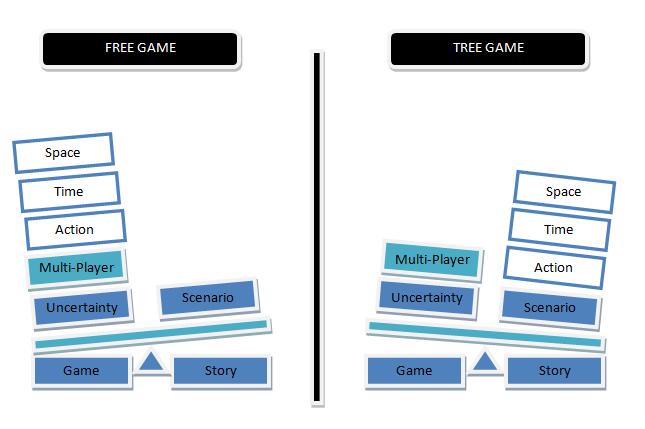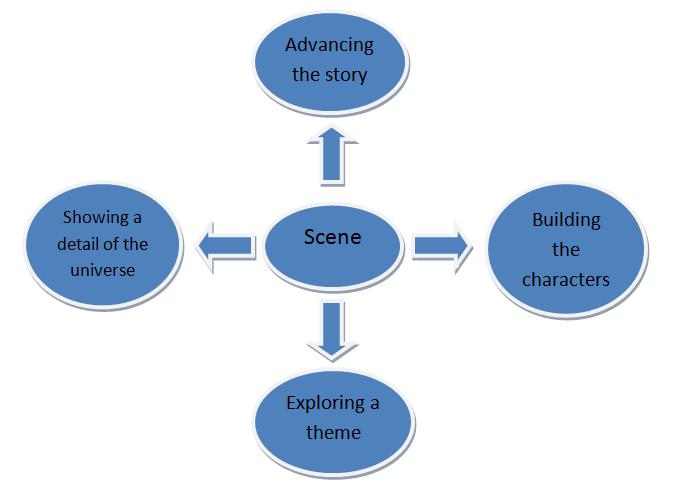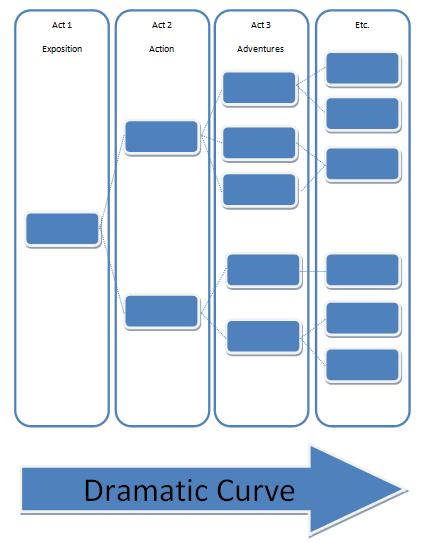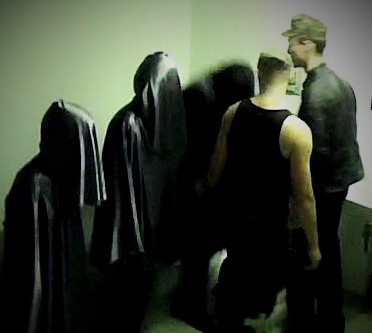Original post: http://www.electro-gn.com/300-legnpararborescence-premierepartie
Translation: Vincent Choupaut
—
This article follows the article in three parts called « Game and Narration », in which I showed different problems of the free game in Larps when they try to create coherent and relevant stories. I will try now to present you a different game model, which contrasts with free game, and tries to answer this simple question: How to create a game which tells a story with narrative coherence and which keeps the essential characteristics which make a game?
In the previous article, I said that if we want to move a larp closer to a real story, we had to control time and space. This is where all begins when you want to control action, plots or scenario. To control time and space is precisely what makes a theater or movie scene. I will speak first about the scene, and then think about it at the heart of a scenes graph.
Creating a scene
We often remember larps for certain scenes, a few ones among all the moments lived during a game. First of all, because we can’t be of course everywhere at the same time. But especially because, of all the moments we live during a game, only a few ones will have enough character, impact, magic (call it like you want) to remain in our memories. Some larp designers thus proceed during their creative approach. They think first of strong or significant scenes, considering what the players will live. When things go well, the wishes of the designers create good memories for the players.
However, we tend to believe that players will spontaneously create tremendous things. That is possible, but the conditions of free game are not really ideal for this. So best put all the chances on our side. Help the players to have good scenes, and through them, good stories.
We find in several larp scenes that were planned before. These moments when the scenic treatment is inviting in the game are nevertheless quite rare. Between two scenes, the free game starts again, with all the problems it may have for the creation of a good story and strong game moments. In a larp based upon free game, every planned scene is an event! But it is just an interlude between two free game phases. In the game format I suggest, there is no game apart from the scenes which set up the story, and which have been planned by the designers before.
Designing a game in terms of scenes is putting back the scene treatment in the foreground in the organization of a larp. Each scene has to carry, for the atmosphere and the proper process of the story, relevant elements for characters and levers which advance the action. The magic of a good game moment should not be left to chance. There are conditions to allow players to live relevant moments – in the absence of being unforgettable. It’s about directing scenes, to carry the action and the performance of characters.
The scene is also an easy device to introduce narrative effects which are commonly used in literature or cinema, like flashback / flashforward / dream / inside life, and that are not easy to introduce in a continuously free game.
In the literary tradition or in the movies, a good scene may fulfill several objectives:
1/ It makes progress the story, giving the spectator all the elements he needs to understand it. Certain films are too didactic and weigh themselves down with superfluous scenes. Others are too sparing with scenes. The good movies have the right number of scenes. Each scene moves closer to the end of the story, linking the adventures in the direction of the climax and the outcome. A scene contains the germs of the next scene. No one is superfluous.
In the case of free game larp, most of the scenes that each player lives have absolutely NO connection with the main plot. A lot of scenes are actually useful to solve secondary plots. That is where we come now.
2/ The scenes for secondary plots allow to build characters, to give them more magnitude. These plots allow exploring different facets of a role.
In larps where there are a main plot and secondary plots, the main plot concerns rarely everybody in a plausible way (the disaster plots, like the world is in danger, supposed to motivate everyone, generally demotivate me). That’s why the designers add many various objectives to everyone, in order that each player has something to do in addition to save the world. So it comes to aberrations like this: Main plot – Save the world which is dying / Secondary plot nr. X – Sell a chicken to your neighbor.
Either the secondary plot is connected to the main plot, so that the player is motivated to solve it, or it has no direct link, so that the solving doesn’t compromise the main plot. This implies no to create plots with disproportionate stakes (save the world / sell a chicken). Indeed, could you seriously tell me how to manage this split in a credible way?
Either the player ignores the threat, represses it, doesn’t want to hear about it (it’s a common defense reaction), or he saves the world, but he forgets his chicken, and also most of his other objectives (calves, cows, pigs…), whose accomplishment is determined by the fact that the world stands up.
In the game format I suggest, there should be just one main plot, in which everyone should be involved and which gives a global direction to the action. The secondary plots, which are peculiar to each character, could be useful to give magnitude to the characters, without being radically heavy on the course of the story.
3/ Exploring a theme: Jealousy, power, sacrifice, friendship, and so on. A scene speaks about something, independently of the plot and the scenario. It provides a subject for the players, through the characters.
In a larp, it is a good way to ask ourselves what is subject that the scene should tell us about. Keeping it in mind allows that the theme is not too discrete, so that the players may understand and seize it.
4/ Showing a detail of the universe, which is integrated into the scene.
In the case of a larp, for example, you don’t have to decorate the entire place, but just put in the scenes elements to evoke the universe.
Building a good scene is integrating these different functions into a harmonious unity. It is not about saying to the player what he has to do, it is about setting up elements he will seize (or not), and always with his style, words, gestures and choices. There are more clues, incentives, potential interaction elements.
The questions for a film-maker and his crew are of this kind:
– Which scenes to choose to tell the best story, so that everyone may understand the direction of the action?
– What is the ideal duration of a scene?
– Which characters have to be present in the scene?
– How the scene could make evolve or give rise to the plot of this character?
– …
In a larp model by scenes, as I conceive it, the designer must think like that.
Creating a succession of scenes
A succession of scenes, in other words… a scenario. A narration might have several patterns. One of them is the scenario. We can define it as a determined succession of scenes whose purpose is to tell a story.
The scenario is a narrative device that we generally depict with a dramatic curve, which describes the link of events, from the initial state to trigger event of the action, until the outcome, by way of a set of adventures and a climax. It is also a technical device which allows cutting up the action in different scenes and structuring the story. There are scenes in free game larp, but they are often not enough to structure effectively the story.
We all have read “Choose your own adventure books” or played adventure video games. They are interactive fictions which have known their moment of glory, but that are now considered as outmoded. The model of the “Choose your own adventure book” is contemporary of the adventure video game in text mode. They were both outmoded with the arrival of graphic adventure games (like “point & click” games), which have themselves left the forefront.
Ironically, the trees logics upon which these games were based, which are considered outmoded in the world of video games, could be innovative in the world of larps, with some adaptation. Remember what says Greg Costikyan: To be sure that a story is told in a game, the game has to be linear, because, after all, stories are linear.
A story is linear (there is a precise order in which things happen). The “choose your own adventure book” or the adventure video game allows different paths through the scenario. It leads to think about the game in terms of graph, like a storyboard, but where we can keep the uncertainty, without which the game is not a game anymore. So we have to move away from this complete linear diagram.
In a classic game, there are phases of free game in which organizers intervene and decide instead of players, sometimes even against them. It may even concern the end of the game, in other words the outcome of the scenario.
The logic of game format I suggest is different: it is about giving regularly alternatives to the players, in keeping with the logic of their characters, and planning the appropriate scenes before the game. So we go over from a model where organizers tell the players what they have to do (including implicitly), to a model where organizers tell the players what they can do.
In this outline, some scenes might be mandatory, but the idea is that all the scenes are optional, except from the first scene(s) of the game. Of course, some stories might give rise to the constraint of a compulsory scene. The designer / organizer has to decide. Try to have these scenes as little as possible, to keep the essence of game.
Now that the principle of the game is set up, we will study in the next part of this article some specificities created by this model.






